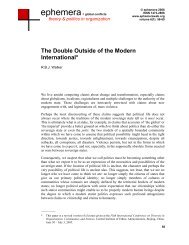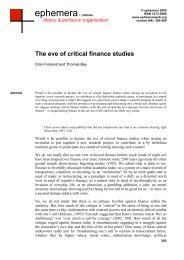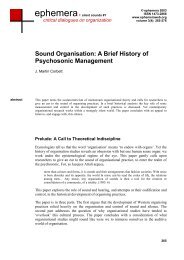Work, play and boredom - Ephemera
Work, play and boredom - Ephemera
Work, play and boredom - Ephemera
Create successful ePaper yourself
Turn your PDF publications into a flip-book with our unique Google optimized e-Paper software.
© 2011 ephemera 11(4): 450-465 Poker phases<br />
articles Ole Bjerg<br />
become very strong if they improve on the draw, for instance four cards to a flush) that<br />
is a crucial element of poker today is also made possible by these innovations. Another<br />
important consequence of the introduction of the draw <strong>and</strong> the additional round of<br />
betting is that <strong>play</strong>ers are given more information to work with in order to deduce the<br />
content of an opponent’s h<strong>and</strong>. If for instance an opponent merely calls on the first<br />
round of betting, draws only one card a then bets aggressively on the second round of<br />
betting there are justified reasons to believe he is holding a straight or a flush. Similarly<br />
the introduction of jackpots not only contributes to limiting the most reckless bluffing,<br />
it also gives <strong>play</strong>ers the possibility of gaining valuable information about opponents’<br />
possible holdings, provided <strong>play</strong>ers are able to process this information. In the fully<br />
developed form of Draw poker, capacity for logical deduction <strong>and</strong> a sense of probability<br />
theory supplement the ability to judge opponent’s character as means to gain an edge in<br />
the game.<br />
We have seen in the above how poker in its basic form relies on the difference <strong>and</strong><br />
detachment of the sphere of betting from the sphere of actual h<strong>and</strong>-values <strong>and</strong> how this<br />
difference may be conceived in terms of Marx’ distinction between exchange-value <strong>and</strong><br />
use-value. With the refinement of the game <strong>and</strong> the development of Draw poker during<br />
the course of the 19th century, this difference is taken one step further.<br />
As poker evolves <strong>and</strong> the strategic element comes to the fore at the expense of pure<br />
chance, the outcome of the game is to a higher degree determined by the <strong>play</strong>ers’<br />
strategic decisions rather than the r<strong>and</strong>om distribution of cards. In other words, the<br />
game is determined by the <strong>play</strong>ers’ actions in the sphere of betting rather than the cards<br />
they are dealt in the sphere of h<strong>and</strong>-values. In so far as the sphere of betting is<br />
comparable to the negotiation of exchange-value in the market, we can say that the<br />
evolution of poker from a game of chance to a game of strategy is comparable to the<br />
development of market immanent mechanisms for the determination of exchange-value<br />
in capitalist society, which Marx describes. Winning in poker is a matter of the <strong>play</strong>er<br />
mastering the ‘market mechanisms’ of the game <strong>and</strong> negotiating the ‘exchange-value’<br />
of the h<strong>and</strong>s in a way that redistributes the value at stake in the game at his benefit.<br />
Depending on his level of skill, the <strong>play</strong>er will be to some degree able to compensate<br />
for an eventual lack of strong h<strong>and</strong>s. Just as the capitalist in the analysis by Marx, the<br />
skilled Draw poker <strong>play</strong>er is able to extract more value from the sphere of exchange<br />
than he puts into it. What we see in poker at this stage is a simulation of the laws of the<br />
market systematically redistributing value in a way not necessarily corresponding to the<br />
use-value being fed into the market.<br />
The 19th century was an era of industrialization that transformed the US from an<br />
agricultural economy to the largest <strong>and</strong> most competitive industrial nation in the world.<br />
As the American Frontier moved westwards, more <strong>and</strong> more areas of the continent were<br />
subsumed by an industrial capitalist mode of production. And as civilisation <strong>and</strong><br />
development progressed, the West became less <strong>and</strong> less Wild. The construction of the<br />
rail-road system is an illustrative example of this historical development. The first<br />
mechanised passenger trains were put into operation in the 1830s <strong>and</strong> a climax in the<br />
history of the American railroads was reached in 1869 when the first transcontinental<br />
railroad was completed.<br />
455








